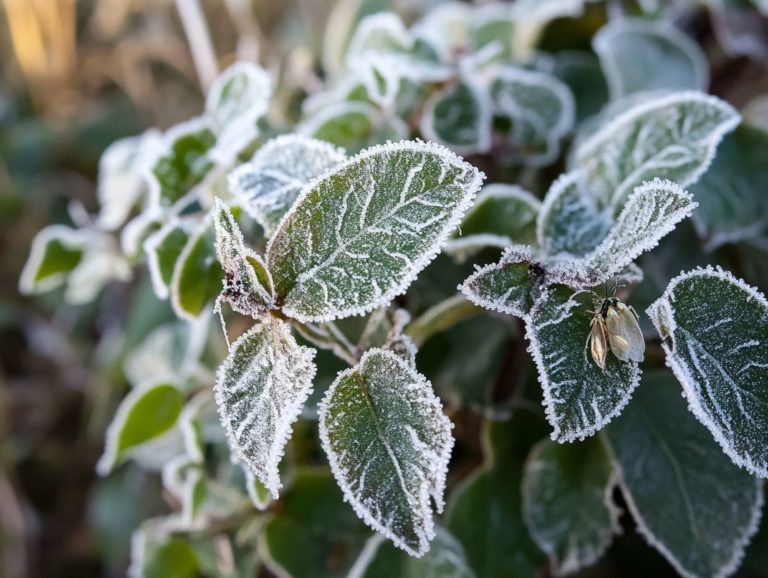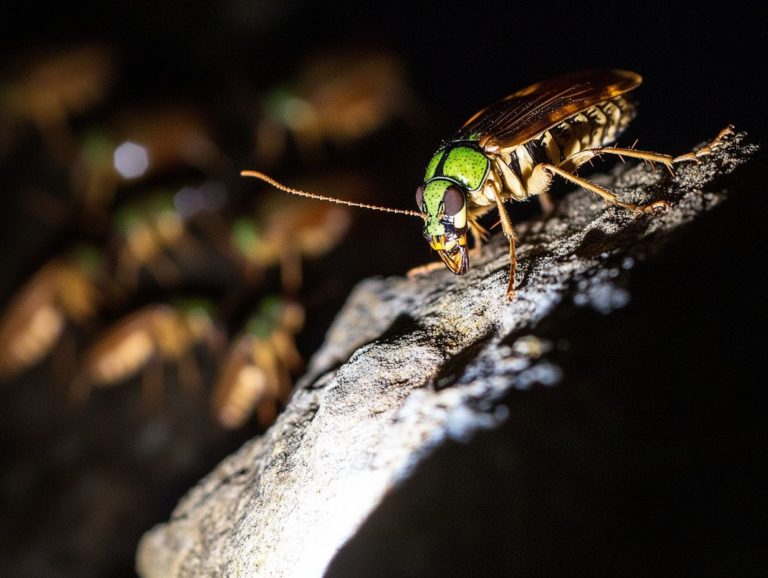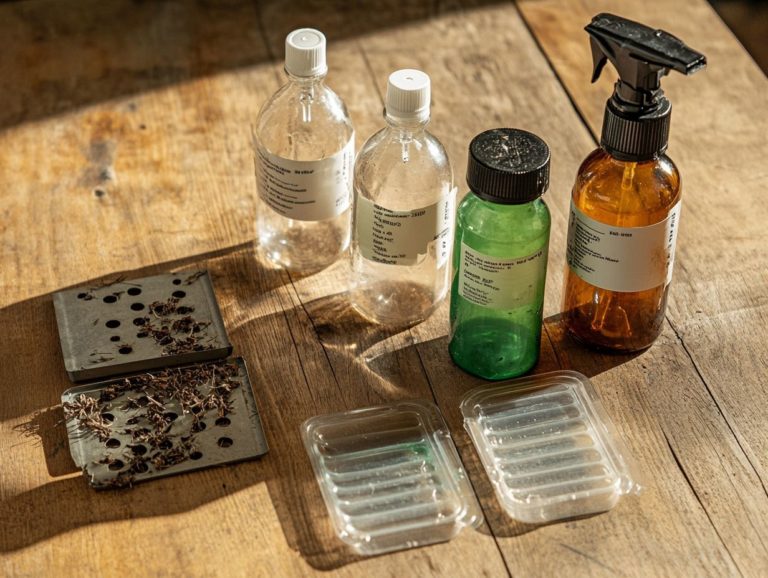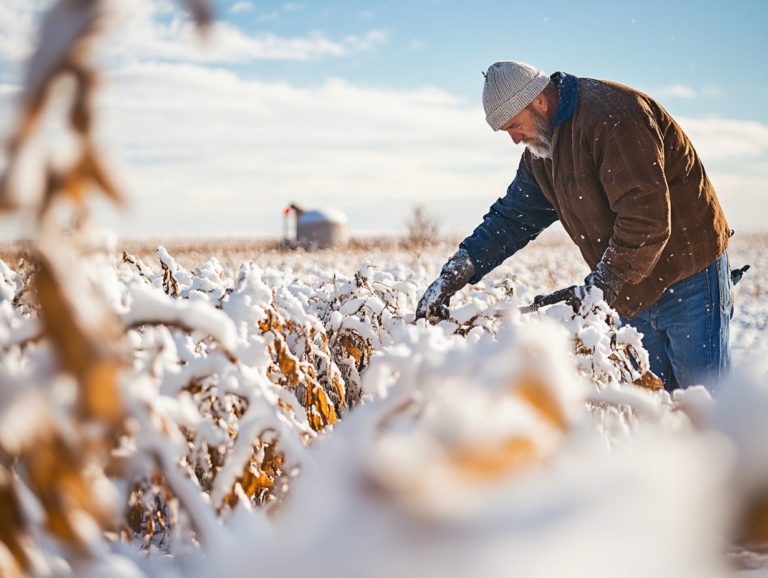5 Common Diseases Affecting Cold-Weather Crops
Cold-weather crops present a unique blend of opportunity and challenge for you as a farmer, particularly when grappling with a range of crop diseases that can jeopardize your yield. This article delves into five common issues you may encounter: frost damage, powdery mildew, downy mildew, blackleg, and white mold.
Each section outlines the symptoms and causes of these plant diseases while offering effective prevention and treatment strategies tailored for your needs. Grasping these challenges is vital for successful cultivation in cooler climates. Continue reading to arm yourself with the essential knowledge needed to ensure your crops not only survive but thrive.
Contents
- Key Takeaways:
- 1. Frost Damage
- 2. Powdery Mildew
- 3. Downy Mildew
- 4. Blackleg
- 5. White Mold
- What Are Cold-Weather Crops?
- What Are the Causes of Frost Damage?
- How Can Farmers Protect Their Crops from Frost Damage?
- What Are the Symptoms and Effects of Powdery Mildew?
- How Can Farmers Prevent and Treat Powdery Mildew?
- What Are the Causes and Symptoms of Downy Mildew?
- How Can Farmers Prevent and Treat Downy Mildew?
- What Is Blackleg and How Does It Affect Cold-Weather Crops?
- How Can Farmers Prevent and Treat Blackleg?
- What Is White Mold and How Does It Affect Cold-Weather Crops, Particularly in the Agricultural Industry?
- How Can Farmers Prevent and Treat White Mold?
- What Are the Best Practices for Growing Cold-Weather Crops?
- Frequently Asked Questions
- What is downy mildew?
- How does gray mold affect crops?
- What are black spots, and how do they affect wheat and barley?
- What is leaf blight?
Key Takeaways:
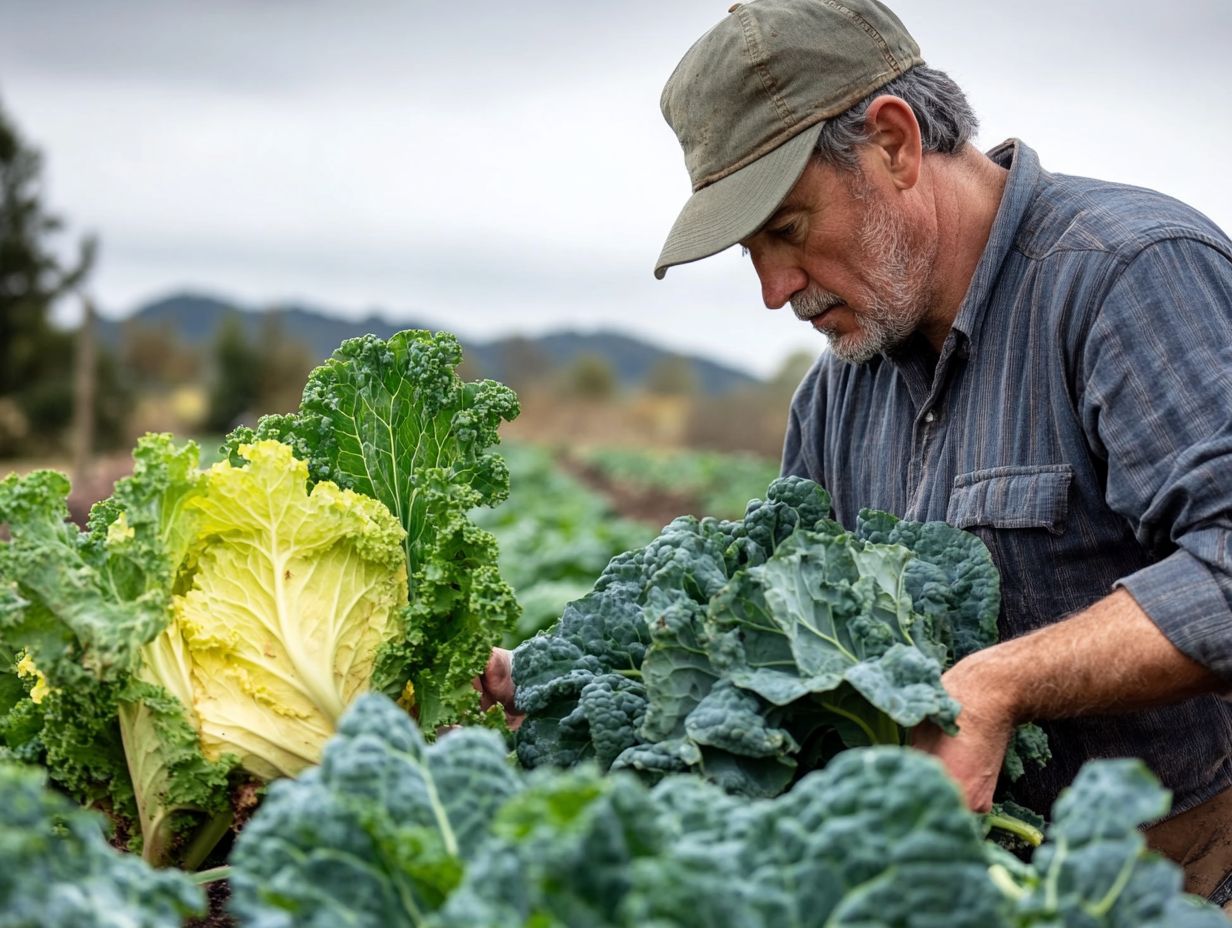
- Frost damage is a common threat to cold-weather crops, caused by freezing temperatures and can result in wilting, discoloration, and death of plants.
- Powdery mildew is a fungal disease that affects cold-weather crops, causing white powdery patches on leaves and stems. It can be prevented by proper sanitation and treatment.
- Blackleg and white mold are also common diseases affecting cold-weather crops, caused by bacteria and fungi respectively. They can be prevented through crop rotation, proper drainage, and use of disease-resistant varieties.
1. Frost Damage
Frost damage poses a significant challenge in the agricultural sector, especially for cold-weather crops like wheat, barley, and spinach. This issue can result in economic losses and complicate crop monitoring efforts. To address this, you must implement effective control strategies that safeguard your crops while protecting the environment and ensuring profitability. Understanding the top 5 challenges in winter gardening is crucial for protecting your crops and ensuring a bountiful harvest!
To shield your crops from frost, consider practices like using row covers, which act as a cozy blanket, trapping heat to keep your plants warmer. Frost alarms are another smart investment, alerting you to impending cold snaps so you can take action. Additionally, employing soil management techniques like mulching can help regulate soil temperature, providing a buffer against sudden drops.
Leverage technology to monitor weather conditions think sensors and satellite imagery to enhance your awareness of microclimates that might negatively impact crop health. By grasping these environmental nuances and strategically intervening, you can significantly mitigate the risks associated with frost, paving the way for more resilient and productive agricultural practices.
2. Powdery Mildew
Powdery mildew is a persistent fungal disease that can affect your crops, including lettuce, kale, and tobacco. You ll recognize it by those telltale white, powdery spots on the leaves, which can hinder your plants growth and yield.
This pesky disease thrives in warm, dry environments and often spreads through wind or water droplets, making it particularly troublesome during certain growing seasons. You might notice symptoms like stunted growth, curling leaves, or even premature leaf drop—definitely not what you want, as these can severely impact your crop quality and profitability. Catching the infection early is essential; look out for discolored leaves that may succumb to further stress. Additionally, be aware of common cold-weather garden pests that can exacerbate these issues.
To combat this issue effectively, consider these control measures:
- Applying fungicides.
- Introducing resistant plant varieties.
- Practicing crop rotation.
Keep a close eye on environmental conditions to mitigate outbreaks of common crop diseases, especially during winter. Understanding the top 5 challenges of winter gardening can help ensure your crops remain healthy and strong.
3. Downy Mildew
Downy mildew is a significant crop disease that affects a variety of plants, particularly in high humidity conditions. This disease can quickly lead to devastating losses if not addressed immediately, presenting challenges for farmers seeking effective management solutions.
Thriving in warm, moist environments, downy mildew is often found in crops like grapes, cucumbers, and lettuce. Recognizing it early is essential. Look for symptoms such as yellow, blighted patches on leaves and a grayish mold on the undersides.
You can adopt several preventive measures, such as:
- Make sure your crops have good air circulation
- Use proper irrigation techniques
- Practice crop rotation to lower humidity levels
Environmentally friendly treatment options are available as well. Utilizing organic fungicides substances that kill or inhibit the growth of fungi and biologically-based control agents can effectively manage outbreaks of fungal disease while minimizing your ecological footprint.
4. Blackleg
Blackleg is a serious disease that poses a significant threat to cold-weather crops like canola. It is caused by a fungus that leads to stunted growth and dark lesions. This condition jeopardizes the economic viability of farmers facing its repercussions.
The pathogen flourishes in damp, cool environments, making crops particularly vulnerable during wet seasons or in regions with heavy rainfall. You might first observe telltale signs such as yellowing leaves and the distinctive darkening of stems. These symptoms can quickly escalate into severe issues, ultimately resulting in wilting and premature plant death.
You can fight back against this disease by implementing combined pest control methods. Utilizing crop varieties that demonstrate resilience against infection can make a substantial difference. Implementing crop rotation and maintaining proper field sanitation practices can significantly diminish the presence of blackleg and other crop diseases.
5. White Mold
White mold is a fungal disease that primarily targets beans and sunflowers, appearing as a white, fluffy growth on affected plant tissues. This disease can quickly lead to devastating losses if not addressed immediately, making diligent management practices essential.
This troublesome fungus thrives in cool, moist environments and often makes its grand entrance during blooming or harvest periods when plants are particularly stressed. You might notice symptoms like wilting, yellowing leaves, and that unmistakable cottony mycelium that can envelop your crops.
You can tackle this challenge by considering crop rotation and selecting resistant varieties. Maintaining proper sanitation by removing infected debris and applying fungicides at the right time can help keep your crops healthy while minimizing environmental impact.
By striking a balance between effective treatment and ecological responsibility, you can safeguard your yield and protect the surrounding ecosystem. Take action today to ensure a sustainable future for your crops!
What Are Cold-Weather Crops?
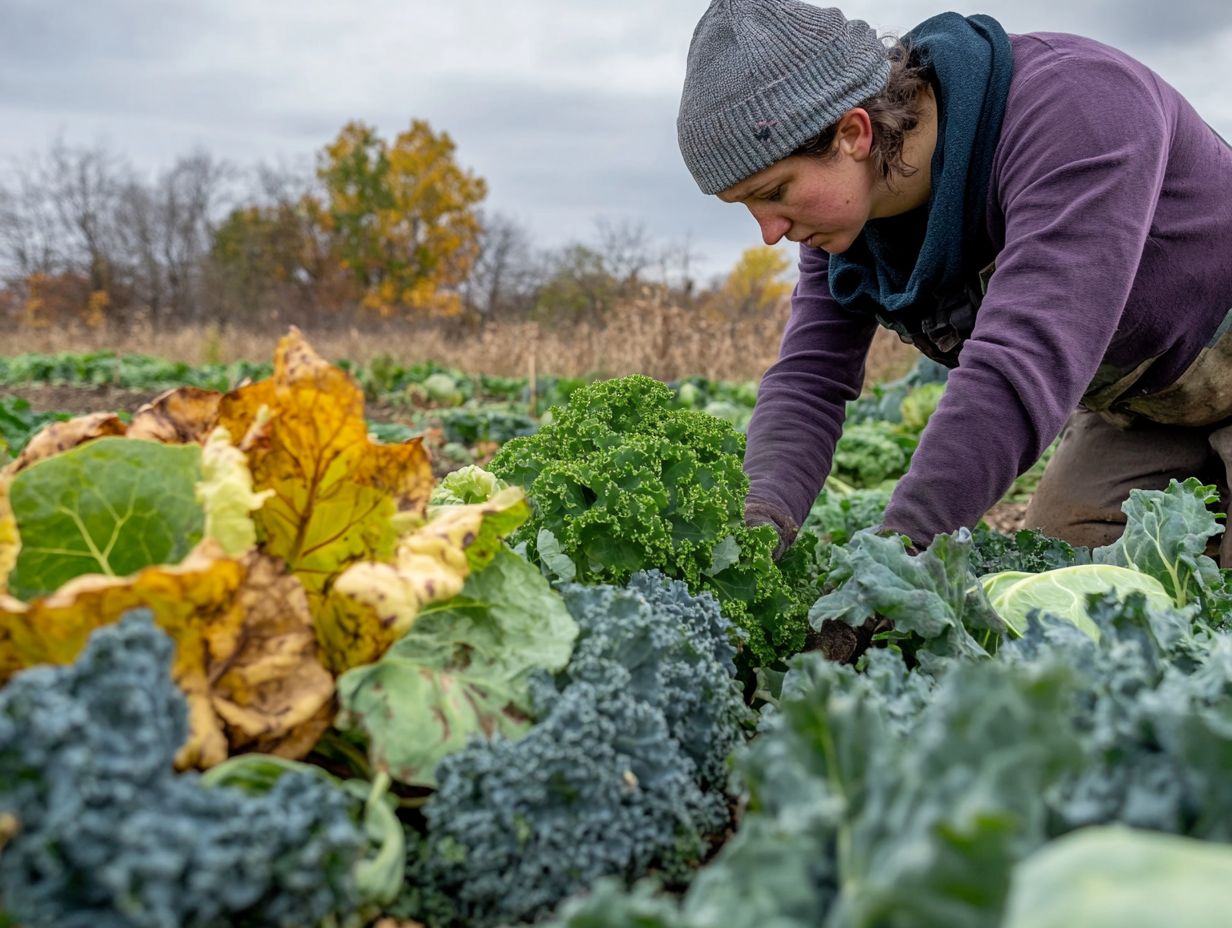
Cold-weather crops are plants like spinach and kale that thrive in cooler temperatures. However, they are also prone to various crop diseases, which can pose challenges for farmers. By following essential cold-weather crop maintenance tips, farmers can navigate these challenges while aiming for profitability and environmental care.
These crops are crucial for extending the growing season and providing fresh produce during months when other plants may falter. Their role in agriculture contributes to food diversity and sustainability that you can’t ignore.
Challenges such as fungal infections, pests, and nutrient deficiencies can jeopardize their yields. To tackle these issues, you can adopt strategies like a method that combines different ways to control pests, crop rotation, and cultivating resistant varieties, all of which help safeguard your harvest.
By implementing these approaches, you not only ensure the health of your crops but also maintain profitability and enhance crop protection. For more insights, consider identifying common winter plant diseases, allowing cold-weather crops to continue playing a vital role in the agricultural landscape.
What Are the Causes of Frost Damage?
Frost damage occurs due to sudden temperature drops, high humidity, and poor monitoring of crops. These factors can leave your plants vulnerable to freezing conditions and diseases, making it essential to be aware of common soil problems in cold-climate gardens.
These environmental elements often come together in surprising ways, particularly during late spring or early autumn when plants are at their most vulnerable. Recognizing these risk factors is essential for you as a farmer.
By implementing strategies like real-time temperature monitoring with sensors and weather forecasts you can forecast potential frost events. Adjusting your planting schedules or using protective coverings can provide a buffer against those unexpected cold snaps.
Grasping these dynamics not only protects your yield but also boosts the overall sustainability of your farming practices in colder climates, fostering profitability.
How Can Farmers Protect Their Crops from Frost Damage?
Protecting your crops from frost damage is key to thriving in the agricultural landscape. You can implement several protective measures, such as using row covers, ensuring timely irrigation, and selecting the right planting dates to enhance crop protection.
To guard against temperature drops, monitor local weather patterns like humidity. Understanding the microclimates in your fields is vital for reducing crop diseases.
By employing row covers, you create a barrier that traps heat and protects vulnerable plants during those critical early morning hours when frost is most likely, particularly affecting crops like winter greens.
Timely irrigation also plays a role; it raises the ambient temperature around your crops since water releases heat when it freezes. By selecting planting dates that align with the regional average frost-free period, you allow your crops to mature before the cold makes its unwelcome return, enhancing yields and supporting long-term viability.
What Are the Symptoms and Effects of Powdery Mildew?
You ll recognize the symptoms of powdery mildew, a prevalent fungal disease by the telltale white, powdery spots on your leaves, stunted growth, and an unfortunate tendency for leaves to drop. These signs can significantly compromise the overall health and yield of your crops.
Typically, you ll find these visible markers on the upper surfaces of the leaves, making it relatively easy to spot the disease early, especially by identifying symptoms like black spots. As the infestation escalates, you might notice the leaves curling or taking on a yellow hue, indicative of stress. This stress may be caused by diseases like the mosaic virus, ultimately hindering photosynthesis.
This decline in plant health can directly affect fruit set, crucial for crops such as canola and spinach. It is an especially critical concern for farmers who depend on these crops for their livelihoods. Early diagnosis of crop diseases is vital; regular monitoring is essential. A regular check for that characteristic white coating can lead to timely interventions.
Being aware of the environmental conditions that promote its growth, such as high humidity and poor air circulation, can empower you to develop more effective management strategies to combat these risks.
How Can Farmers Prevent and Treat Powdery Mildew?
You can effectively prevent and treat powdery mildew through various strategies, such as changing the types of crops planted in a field each season, choosing resistant varieties, and applying fungicides chemicals used to kill or inhibit the growth of fungi. These are essential components of a robust disease management plan.
Ensure proper spacing between your plants; this not only helps in disease management but also promotes healthy growth. Proper spacing can significantly enhance air circulation, which reduces humidity levels that typically encourage mildew to thrive.
Keep a close eye on your crops to catch issues early! Regular monitoring allows you to intervene promptly to mitigate the effects of pathogens and potential damage. By selecting resistant crop varieties, you promote healthier yields over time.
While fungicides act as a vital line of defense, it s important to apply them wisely. Resistance buildup among pathogens can lead to ineffective treatments. Alternating products and strictly following label guidelines for fungicide application should be part of a comprehensive disease management strategy to protect crops.
What Are the Causes and Symptoms of Downy Mildew?
Downy mildew results from specific pathogens like fungi that flourish in high humidity. Symptoms include yellowing leaves and a downy growth on the undersides of those leaves. This condition can significantly compromise crop health.
You re likely to encounter this disease under cool, damp conditions, especially when air circulation is subpar. Early identification of downy mildew is essential, as it can spread rapidly through spores. The symptoms aren t just limited to those telltale yellow patches; stunted growth and potential crop losses can also occur. Regular monitoring of your crops particularly after extended periods of moisture can be instrumental in catching any issues early.
To manage this persistent threat effectively, consider incorporating the following practices into your integrated management strategy:
- Crop rotation
- Selecting resistant varieties
- Applying appropriate fungicides
These steps can help control the spread of downy mildew and mitigate its impact on your yields.
How Can Farmers Prevent and Treat Downy Mildew?
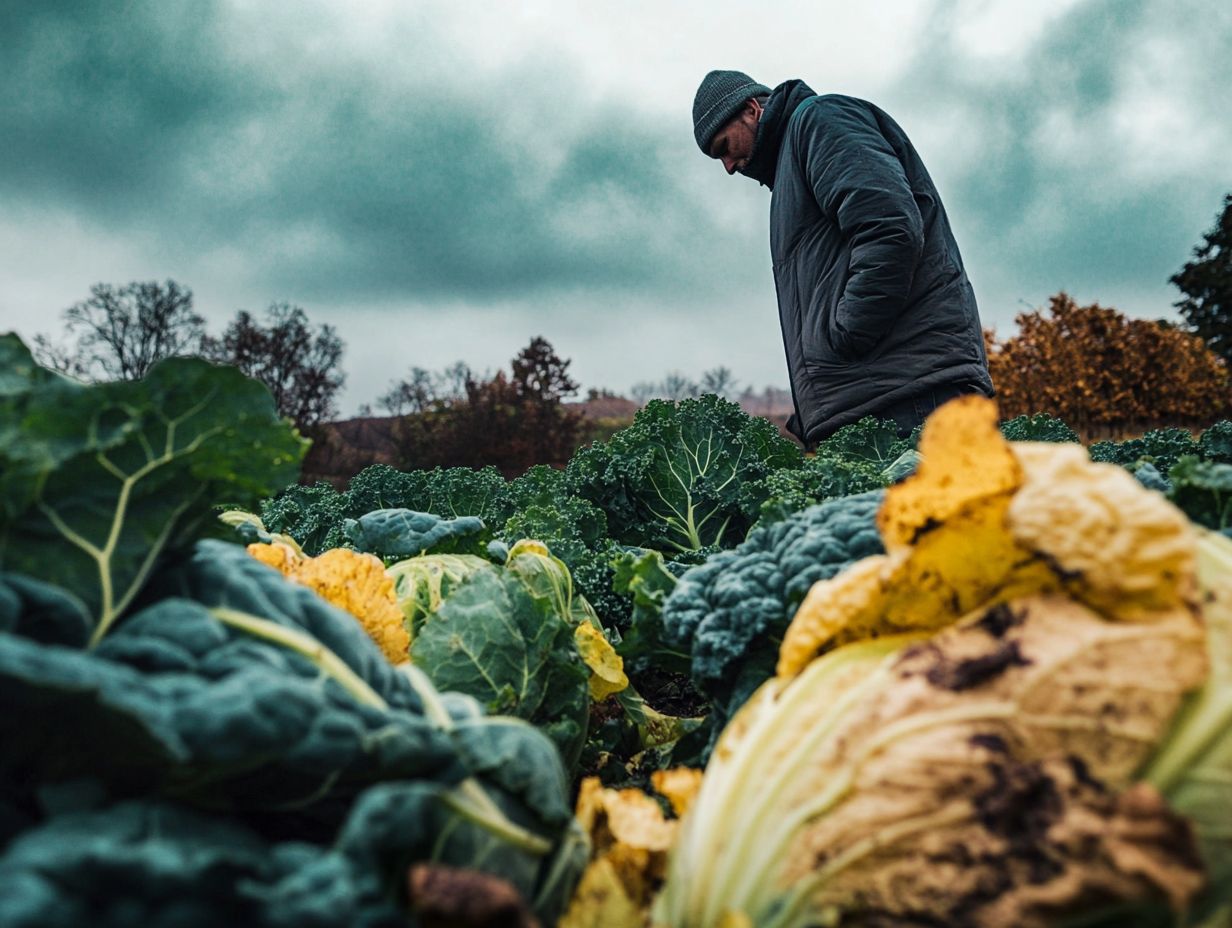
Discover how farmers can fight downy mildew and protect their crops! Farmers can effectively prevent and treat downy mildew by implementing strong disease management practices, such as crop rotation and selecting resistant varieties. Applying fungicides is also essential for managing this disease.
Using integrated pest management strategies can greatly enhance your ability to tackle this persistent challenge. This approach involves closely monitoring environmental conditions and pest populations. The best timing for treatments can help manage diseases effectively.
Incorporating beneficial organisms natural agents that help keep harmful pests and diseases at bay can also be pivotal in managing downy mildew. By adopting improved cultural practices, such as ensuring proper drainage systems to prevent excess moisture, you can minimize fungal growth through careful monitoring and management practices, as well as timely irrigation.
By favoring resistant crop varieties, you not only diminish the risk of infection but also foster a more sustainable agricultural approach to managing crop diseases effectively. This leads to healthier yields and contributes positively to soil health, which is essential for promoting robust crop growth.
What Is Blackleg and How Does It Affect Cold-Weather Crops?
Blackleg is a fungal disease that threatens crops like canola, impacting farmers’ economic stability. This pathogen reveals itself through a range of symptoms, including dark lesions on stems. Premature flowering is one of the symptoms of blackleg, ultimately leading to reduced yields and compromised quality of produce.
The ramifications are particularly severe in regions where these crops are essential. This situation causes not only financial strain but also significant market fluctuations that can arise from the impacts of severe crop diseases.
To fight this disease urgently, adopt integrated management strategies like:
- Crop rotation
- Utilizing resistant varieties
- Practicing proper sanitation techniques is crucial for maintaining crop health
By implementing these measures, you can greatly diminish the incidence and severity of blackleg, ensuring the sustainability of your farming operations.
How Can Farmers Prevent and Treat Blackleg?
You can effectively prevent and treat blackleg through a variety of strategies. Start by selecting resistant crop varieties, practicing crop rotation, and applying fungicides to manage this disease effectively.
By integrating these methods, you’ll significantly reduce the incidence and severity of blackleg in your fields. Choosing crop varieties bred for resistance not only minimizes the risk of infection but also enhances your overall yield. Implementing crop rotation with non-susceptible crops disrupts the disease cycle, making it harder for pathogens to establish themselves in the soil.
When outbreaks do occur, the careful application of fungicides provides an additional line of defense. By emphasizing an integrated disease management approach to combat both blackleg and powdery mildew effectively, you pave the way for more sustainable farming practices and healthier crops.
Take action today to protect your crops and ensure a successful harvest!
What Is White Mold and How Does It Affect Cold-Weather Crops, Particularly in the Agricultural Industry?
White mold is a fungal disease that poses a serious threat to cold-weather crops, particularly beans and sunflowers. This insidious pathogen can lead to significant yield losses, affecting overall profitability in farming. To safeguard your harvests, it’s vital to adopt effective management practices.
Thriving in cool, moist environments, white mold becomes especially problematic during periods of high humidity and poor air circulation. You might notice a white, fluffy mycelium on infected plant tissues. This is a key symptom of white mold, accompanied by wilting and discolored leaves. As the disease progresses, it can cause the rotting of stems and fruits in severe cases, reducing not just the quantity of your harvest but also severely compromising its quality.
Act now! Monitor your fields closely for early signs of white mold. Employ strategies like crop rotation, selecting resistant varieties, and implementing proper irrigation techniques to help manage moisture levels and minimize its spread effectively.
How Can Farmers Prevent and Treat White Mold?
You can prevent and treat white mold by employing practices such as crop rotation, proper irrigation management to minimize moisture that encourages disease spread, and fungicide application, which is a chemical that kills or inhibits fungal growth. All these measures are crucial for effective disease management.
Understanding crop rotation helps you disrupt the life cycles of pathogens effectively. By maintaining adequate moisture levels through careful irrigation, you can minimize the conditions that foster fungal growth. The strategic use of fungicides, when combined with these agronomic practices, provides a proactive approach to controlling outbreaks.
Staying informed about the latest research helps farmers improve their strategies against pathogens. Recommendations for fungicide application will empower you to tailor your strategies effectively, ensuring they meet the specific needs of your fields.
What Are the Best Practices for Growing Cold-Weather Crops?
Implementing best practices for growing cold-weather crops is essential for ensuring healthy yields of crops like kale and tobacco. Pay attention to 5 signs your winter crops need attention and focus on strategies that prioritize crop protection practices, disease management, and environmental sustainability, as they all play a role in crop monitoring and disease management.
Overall, fostering healthy agricultural ecosystems requires an integrated approach to crop protection and disease management. Through effective treatment and management, farmers can safeguard their crops and ensure economic profitability for the agricultural industry.
By carefully selecting optimal planting times, you can synchronize your cultivation efforts with favorable weather conditions that encourage growth. Additionally, maintaining soil health is equally important; regular testing and enriching the soil with organic matter will maximize nutrient availability.
Proactively monitoring for diseases allows you to act quickly. This safeguards your crops and enhances overall resilience. By integrating these practices, you can significantly boost economic profitability and sustainability, minimize losses, and sustain your agricultural ecosystems.
Frequently Asked Questions
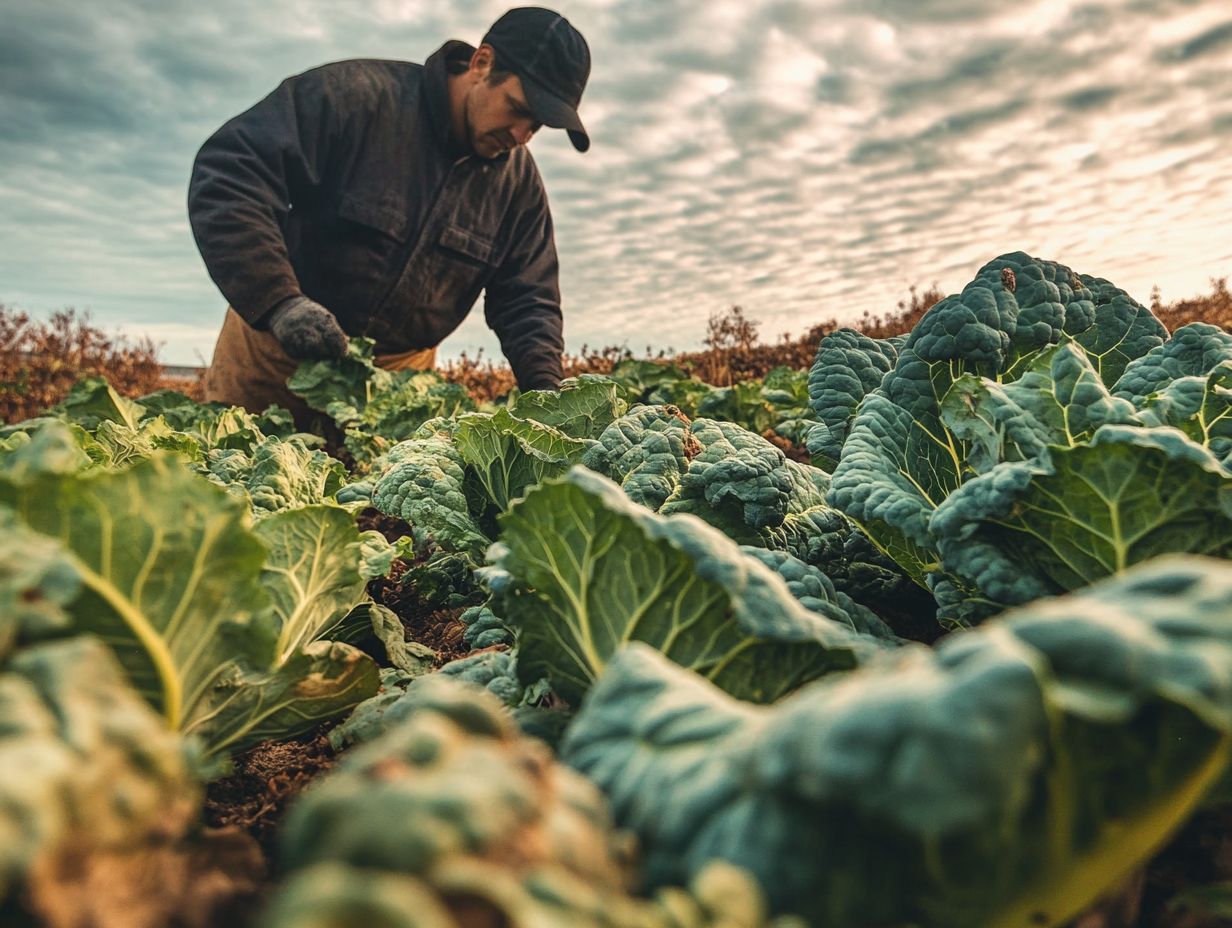
How does powdery mildew affect cold-weather crops?
Powdery mildew is a fungal disease that affects the leaves of plants, causing them to develop a white powdery coating. This can lead to stunted growth and reduced yield in cold-weather crops.
What are the most common crop diseases affecting cold-weather crops, including downy mildew and black spots?
The five most common diseases affecting cold-weather crops are powdery mildew, downy mildew, grey mold, black spot, and leaf blight. For more insights, check out 5 things to know about winter crop diseases, as leaf blight is often exacerbated by environmental factors.
Start implementing these best practices today to protect your crops and boost your yield!
What is downy mildew?
Downy mildew is a type of fungus that mainly affects plant leaves. It causes yellow or brown spots and can harm the growth and yield of crops.
How does gray mold affect crops?
Gray mold is a common type of fungus that impacts many plants, including cold-weather crops. It leaves brown or gray spots on leaves, flowers, and fruit, and can lead to plant death if not controlled. Left untreated, gray mold can quickly destroy your plants, so it’s vital to act fast!
What are black spots, and how do they affect wheat and barley?
Black spot is a type of fungus that forms dark spots on the leaves and stems of plants. This disease weakens the plant and reduces crop production.
What is leaf blight?
Leaf blight is caused by bacteria or fungus. It turns plant leaves yellow or brown and can lead to lower yields and even death if treatment is delayed.

